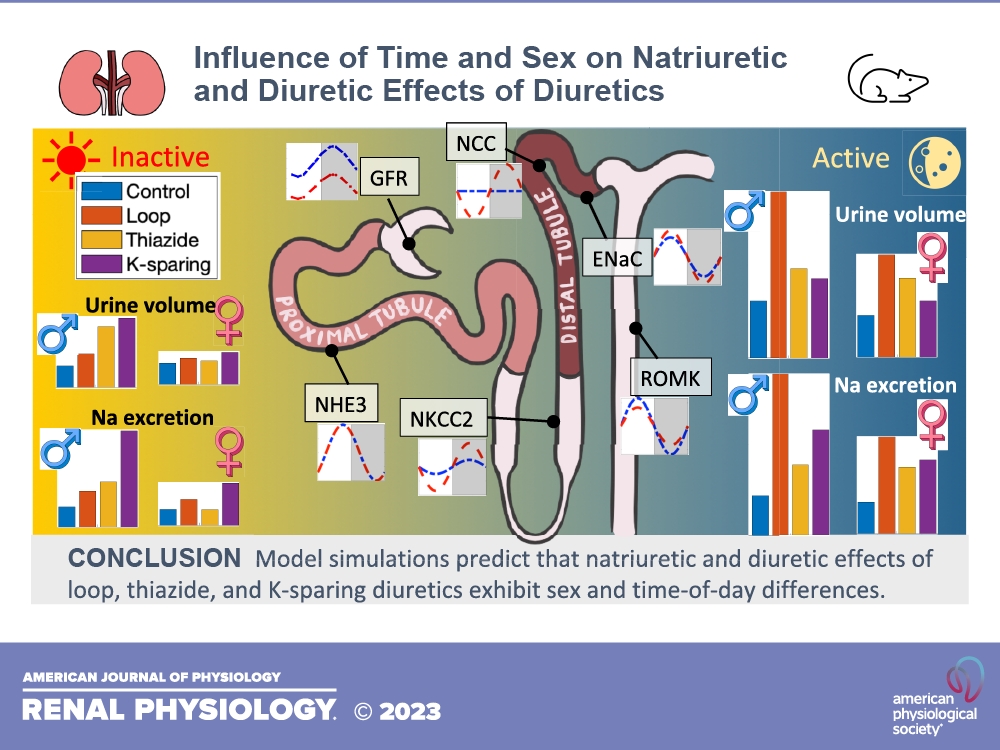一日间及患者性别可能会改变降压药的有效性
诸平
据加拿大滑铁卢大学(University of Waterloo)2023年4月19日提供的消息,该校的研究人员使用数学模型来了解利尿剂的有效性,新研究表明,一天中的不同时间和患者的性别可能会改变某些降压药物的有效性(Time of day and a patient’s sex may alter the effectiveness of blood pressure medication)。相关研究结果于2023年3月1日已经在《美国生理学肾脏生理学杂志》(American Journal of Physiology Renal Physiology)网站发表——Pritha Dutta, Mehrshad Sadria, Anita T. Layton. Influence of administration time and sex on natriuretic, diuretic, and kaliuretic effects of diuretics. American Journal of Physiology Renal Physiology, 2023, 324(3): F274-F286. DOI: 10.1152/ajprenal.00296.2022. Published online 1 March 2023. https://doi.org/10.1152/ajprenal.00296.2022
生理性别(biological sex)和身体的生物钟(body’s circadian clock)是控制血压的关键因素。生物钟是一种调节睡眠-觉醒周期等自然的内在过程,大约每24小时重复一次。在其许多其他功能中,生物钟还调节肾功能。肾脏通过管理体内的液体和电解质水平在调节血压方面起着至关重要的作用。
滑铁卢大学应用数学教授,也是该研究的通讯作者安妮塔·莱顿(Anita Layton)说:“一类重要的降压药是利尿剂(diuretics),有时被称为排水丸(water pills)。利尿剂通过靶向肾功能来降低血压,从而增加身体排泄的尿量。如果它们不能正常工作,它们会对血压产生负面影响。”
安妮塔·莱顿的团队使用数学模型模拟雄性和雌性小鼠的肾功能,以评估各种利尿药物的有效性:髓袢利尿剂(loop diuretics)、噻嗪类利尿剂(thiazide diuretics)和保钾利尿剂(potassium-sparing diuretics)。
首先,研究人员模拟了每只小鼠的昼夜节律(circadian rhythms):夜行动物的夜间为活跃中期,而白天为不活跃周期。然后,他们测量了每种药物在雄性和雌性小鼠中每次预测的尿量和钠排泄量。他们发现,对于每一类利尿剂,性别和一天中的时间对药物效果的影响不同。
尽管人类通常有相反的生物钟——我们白天为活跃周期,晚上为不活跃周期——结果表明,人们可以通过选择合适的服药时间来使他们的血压治疗计划更有效。
“时间疗法或者时辰疗法(Chronotherapy)是根据人体的昼夜节律调整给药方式,可以在改进现代个性化医学方面发挥重要作用,”安妮塔·莱顿说。
上述介绍,仅供参考。欲了解更多信息,敬请注意浏览原文或者相关报道。
Abstract
Sex differences in renal function and blood pressure have been widely described across many species. Blood pressure dips during sleep and peaks in the early morning. Similarly, glomerular filtration rate, filtered electrolyte loads, urine volume, and urinary excretion all exhibit notable diurnal rhythms, which reflect, in part, the regulation of renal transporter proteins by circadian clock genes. That regulation is sexually dimorphic; as such, sex and time of day are not two independent regulators of kidney function and blood pressure. The objective of the present study was to assess the effect of sex and administration time on the natriuretic and diuretic effects of loop, thiazide, and K+-sparing diuretics, which are common treatments for hypertension. Loop diuretics inhibit Na+-K+-2Cl− cotransporters on the apical membrane of the thick ascending limb, thiazide diuretics inhibit Na+-Cl− cotransporters on the distal convoluted tubule, and K+-sparing diuretics inhibit epithelial Na+ channels on the connecting tubule and collecting duct. We simulated Na+ transporter inhibition using sex- and time-of-day-specific computational models of mouse kidney function. The simulation results highlighted significant sex and time-of-day differences in the drug response. Loop diuretics induced larger natriuretic and diuretic effects during the active phase. The natriuretic and diuretic effects of thiazide diuretics exhibited sex and time-of-day differences, whereas these effects of K+-sparing diuretics exhibited a significant time-of-day difference in females only. The kaliuretic effect depended on the type of diuretics and time of administration. The present computational models can be a useful tool in chronotherapy, to tailor drug administration time to match the body’s diurnal rhythms to optimize the drug effect.
NEW & NOTEWORTHY Sex influences cardiovascular disease, and the timing of onset of acute cardiovascular events exhibits circadian rhythms. Kidney function also exhibits sex differences and circadian rhythms. How do the natriuretic and diuretic effects of diuretics, a common treatment for hypertension that targets the kidneys, differ between the sexes? And how do these effects vary during the day? To answer these questions, we conducted computer simulations to assess the effects of loop, thiazide, and K+-sparing diuretics.
转载本文请联系原作者获取授权,同时请注明本文来自诸平科学网博客。
链接地址:https://wap.sciencenet.cn/blog-212210-1385073.html?mobile=1
收藏



